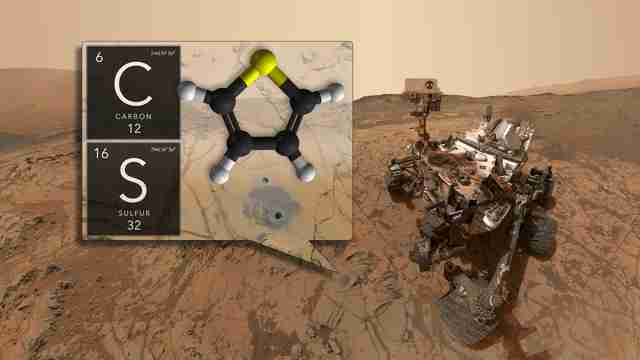 |
| This low-angle self-portrait of NASA's Curiosity Mars rover shows the vehicle at the site from which it reached down to drill into a rock target called "Buckskin" on lower Mount Sharp. |
First, data from NASA’s Curiosity rover has shown for the first time that methane levels in the martian atmosphere have a seasonal cycle. Scientists analyzed three years of atmospheric measurements taken by Curiosity and found low, background levels of methane that rose during summer in the northern hemisphere.
Also, scientists detected organic material preserved in rocks in Gale Crater, which is thought to be an ancient lakebed. The find suggests the planet could have supported ancient life.
The research has been published in the journal Science.
Chris Webster of NASA’s Jet Propulsion Laboratory said the methane discovery showed a discernible pattern in seasonal concentrations of the gas.
“We see a low background level of methane from winter to summer,” he said, “but the seasonal cycle changes by a factor of three, which is a huge change, and was completely unexpected.”
The methane could come from a biological source, but is likely stored in crystals called clathrates, which release the methane into the atmosphere during warmer summer weather.
“The detection of methane is always exciting because 95 percent of Earth’s methane is produced by biology, and so there has always been this interest in Mars methane” Webber said. “Our data shows that something is happening today that is producing it.”
 |
| Curiosity has detected seasonal changes in methane at Gale Crater using its SAM instrument. |
Webber told Seeker the latest announcement is different than past methane discoveries.
“Now we’ve measured a consistent background level, with seasonal spikes of methane,” he said. “The spikes are very important, because the change is so dramatic, some process is causing large pulses of the gas being released.”
The methane concentrations ranged from 0.24 to 0.65 parts per billion.
The organic material detected by Curiosity, according to Jen Eigenbrode of NASA’s Goddard Space Flight Center, had been preserved in martian rocks for over 3 billion years.
Though the molecules are organic, the find doesn’t confirm the existence of life on Mars.
“Curiosity has not determined the source of the organic molecules,” said Eigenbrode. “And we have not determined whether it contains a record of ancient life, or was food for life. But it does give us chemical clues to planetary conditions and processes.”
The source of the organic material could have a meteorite crashing into the Red Planet, for example.
 |
| Curiosity has discovered ancient organic molecules in Gale Crater. |
“We think they haven’t changed over time, as this form of organic matter is resistant to changes,” she said. “But if life was on early Mars and other conditions were favorable, this means the organic biosignatures would be preserved.”
A drill on the Curiosity rover made a 5 centimeter hole in mudstones in Gale Crater at sites called Mojave and Confidence Hills. The rover then heated the rock samples to over 900 degrees Fahrenheit (500 degrees Celsius) and analyzed the molecules that were released. The process revealed the presence of several organic molecules, including carbon, thiophenes, benzene, toluene, and small carbon chains, such as propane or butene.
Like the methane discovery, NASA had also announced in 2014 the detection of organic molecules.
“In 2014, we reported the detection of chlorinated molecules, which is a significant discovery,” Eigenbrode told Seeker. “We had hoped we would find it with the Viking landers in the 1970’s, but we didn’t. While Curiosity’s first detection in 2014 was not what you typically find in natural samples, it did give us a lot of motivation to keep looking because we thought there had to be other layers of organic molecules.”
Read more at Seeker
No comments:
Post a Comment